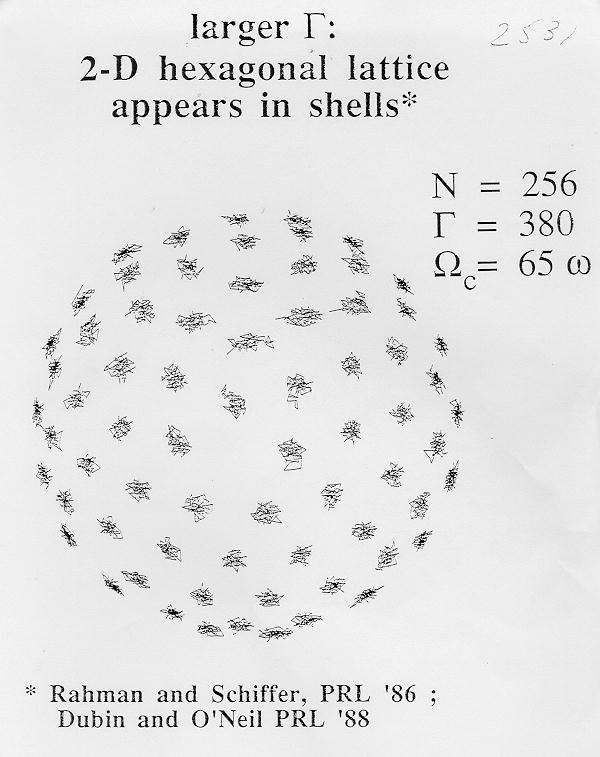

When Ion plasmas are laser-cooled to milliKelvin temperatures, they crystallize into a lattice whose structure depends on the trapping fields. That is, the crystal structure differs from that of the infinite, homogeneous "one-component plasma" because of the finite size of the system.
We have directly studied the effect of finite size on the strongly correlated states by performing computer simulations for N=1 to N=4096 ions in a realistic trap geometry. For N~1->10, the system crystallizes at low temperatures into simple geometrical shapes which can be predicted by minimization of the electrostatic potential energy. An interactive java routine that allows one to view and rotate these 'Coulomb clusters' is now available.
For N~10¹->10³ at moderate temperature and density, the charges form concentric spheroidal shells, rather than a BCC crystal. The charges are localized to a shell surface but wander randomly within the shells. At lower temperatures, diffusion within the shell surfaces decreases and the charges form a distorted 2D hexogonal lattice, as shown in Fig.11. These models lead to a phase diagram for the lattice structure as a function of N, applied voltages, and temperature.

In particular, in the limit of strong radial confinement, the system forms a 1-D coulomb chain. The 1-D coulomb chain is a form of condensed matter which consists of charges confined along a linear axis by application of strong external focusing fields. These chains have been realized in experiments in storage rings and in linear Paul traps, where they have been proposed as the basis for a novel type of atomic clock. In the linear Paul trap experiments, the chain is of finite length, and the spacing a between the ions in the chain is a function of position, z, a=a(z); this spacing depends on the form of the applied trap potential.
For the case where the potential is a quadratic function of position, we have obtained an analytic theory for a(z) as a function of the strength of the applied potential. This is an important result since the chain becomes unstable if the spacing is too small, yet applications require a spacing that is as small as possible; it is therefore important to understand how the spacing depends on trap parameters.
We propose to extend this work to the more general case where the applied potential is of a general, not necessarily harmonic, form. The work is of theoretical as well as experimental interest, since the 1-D Coulomb chain displays some novel effects due to inter-particle correlations. In most plasmas, fluid energy completely dominates over correlation energy. However, in 1-dimensional Coulomb systems, both fluid eneregy and correlation energy are of the same order, and this means that correlation effects cannot be neglected when a(z) is evaluatedl a fluid model for the plasma cannot be used. Instead, we propose to use the local density approximation (LDA) of density functional theory in order to determine the density of the inhomogeneous Coulomb chain. The LDA has produced useful results for this problem for the case of a harmonic trap potential, and we believe it can be generalized to the more general case of general applie potentials.
It has been proposed by the NIST Boulder experimental group to perform Bragg scattering experiments on the crystal lattice. We propose to employ our computer simulations to predict what the experiments should observe when performing a Bragg scattering experiment off of an inhomogeneous trapped ion cloud.